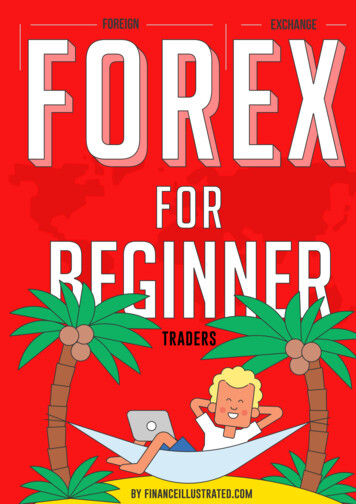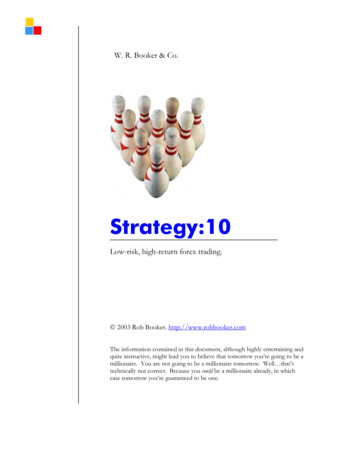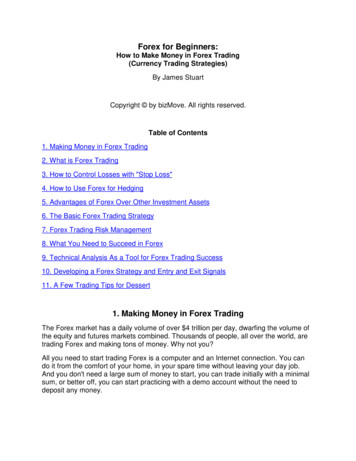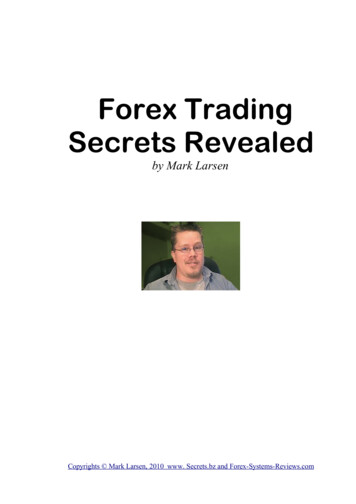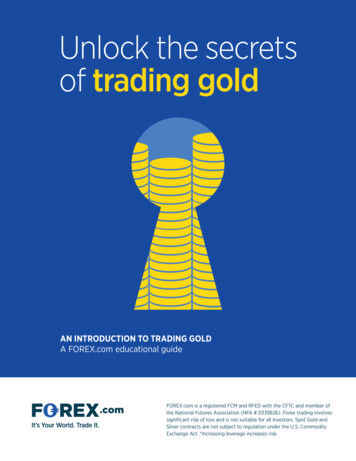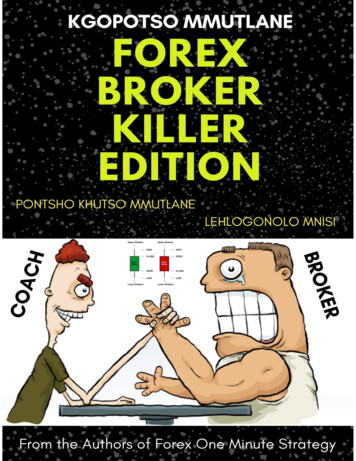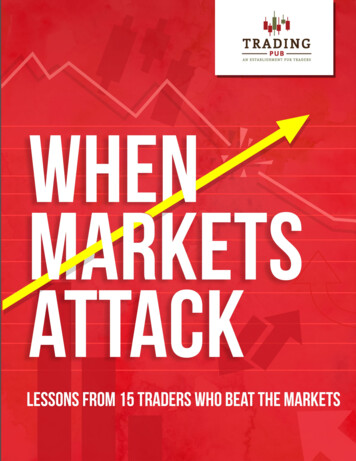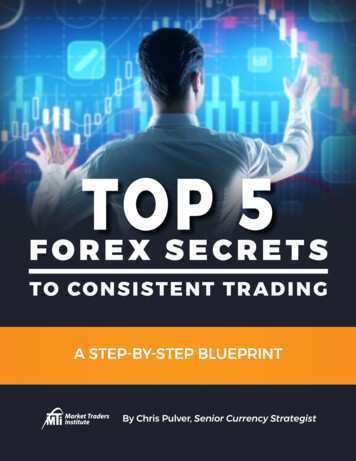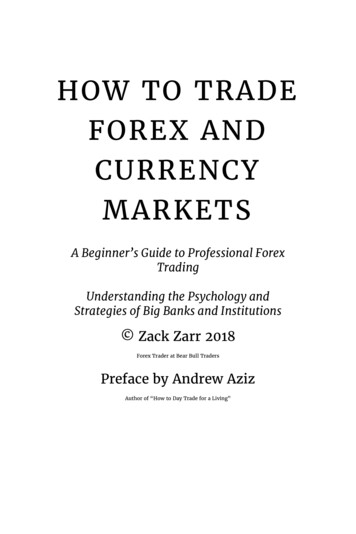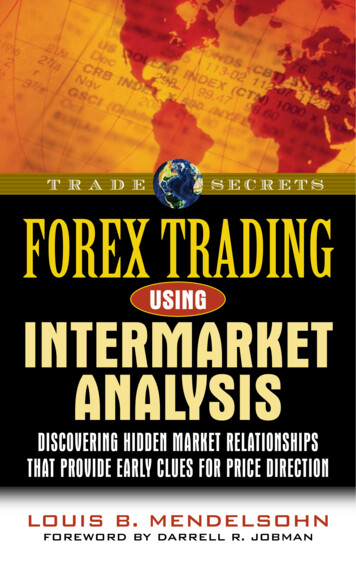
Transcription
T R A D ESECRETSForex TradingusingIntermarketAnalysisDiscovering Hidden Market RelationshipsThat Provide Early Clues for Price DirectionLouis B. MendelsohnForeword by Darrell R. Jobman
ForexTrading UsingIntermarketAnalysis
ForexTrading UsingIntermarketAnalysisDiscovering HiddenMarket RelationshipsThat Provide EarlyClues for PriceDirectionLouis B. MendelsohnForeword by Darrell R. JobmanMarketPlace Books Columbia, Maryland
Copyright 2006 by Market Technologies, LLC. All rights reserved. Reproductionor translation of any part of this work beyond that permitted by Section 107 or108 of the 1976 United States Copyright Act without the permission of the copyright owner is unlawful. Requests for permission or further information should beaddressed to the Permissions Department at Marketplace Books .VantagePoint Intermarket Analysis Software is a trademark of Market Technologies,LLC. Synergistic Market Analysis and Hurricaneomic Analysis are service marksof Louis B. Mendelsohn. All other trademarks, service marks, or registeredtrademarks are the property of their respective owners. Other names, designs,titles, words, logos, or phrases in this publication may constitute trademarks,service marks, or trade names of other entities that may be registered in certainjurisdictions.This publication is designed to provide accurate and authoritative informationand the views and opinions of the author in regard to the subject matter covered.It is sold with the understanding that neither the publisher, copyright holder,nor the author is engaged in (1) providing commodity trading advice based on,or tailored to, the commodity interests or cash market positions or other circumstances or characteristics of any particular client, or (2) rendering investment,legal, accounting, or other professional services. If trading or investment advice orother expert assistance is required, the services of a competent and appropriatelylicensed person should be sought.From a Declaration of Principles jointly adopted by a Committee of the AmericanBar Association and a Committee of Publishers.This book, along with other books, is available at discountsthat make it realistic to provide them as gifts to your customers, clients, and staff. For more information on these long lasting, cost effective premiums, please call us at 800-272-2855or e-mail us at sales@traderslibrary.com.ISBN 1-59280-295-8Printed in the United States of America.1 2 3 4 5 6 7 8 9 10
ContentsFOREWORDIXPREFACEXVINTRODUCTIONXIXChapter 1WHAT IS FOREX?1If you have traveled internationally, you may already know something about the forex market, today’s hottest marketplace. Discoverwhy you might want to trade forex.Chapter 2THE FOREX MARKETPLACE11The forex market is the world’s largest marketplace, dwarfing allother markets combined. See how forex grew so large and how youcan participate.Chapter 3FUNDAMENTALS AND FOREX21Forex traders can get plenty of information, sometimes so much thatit can be hard to sift through it all. Here are some reports a forextrader needs to consider.Chapter 4APPLYING TECHNICAL ANALYSIS TO FOREX35With fundamental information overwhelming, many forex tradersanalyze price action in charts. Chart patterns and indicators haveshortcomings, but see how predictive moving averages can help withmarket forecasting.VII
trade secretsChapter 5INTERMARKET ANALYSIS OF FOREX MARKETS49What happens in one market is influenced by what happens in anumber of related markets. Discover why single-market analysisshould give way to intermarket analysis in today’s global marketplace, especially in forex markets, which are ideally suited for thistype of analysis.Chapter 6USING NEURAL NETWORKS TO ANALYZE FOREX63With so many fundamentals and so much influence from related markets, it’s hard to see all the patterns and relationships in the forexmarket. Find out how neural networks can uncover hidden patternsin data and select the best to make short-term market forecasts.Chapter 7TECHNICAL TACTICS FOR TRADING FOREX71Once you understand how the forex market works and the basics oftechnical analysis, you are ready to put theory into practice. Hereare a few more practical tips and chart examples to help you applyyour knowledge to actual trading.Chapter 8WAVE OF THE FUTURE: SYNERGISTIC MARKET ANALYSIS87Using only one approach to trade no longer works in today’s globalmarkets. Successful trading requires the synthesis of technical,intermarket and fundamental approaches.TRADING RESOURCE GUIDEABOUT THE AUTHOR AND MARKET TECHNOLOGIES, LLCVIII93105
F o rex Tra di ng Usi ng Inte rmar ket AnalysisIn the early 1980s, as the editor-in-chief of Commodities magazine, I was privy to a number of different trading ideas and techniques—so many, in fact, it was difficult to determine which wasbest or sometimes which had merit. This was during the heyday ofinnovations in the futures markets with the introduction of the cashsettlement concept in eurodollar futures, futures on broad-based stockindexes, crude oil futures, the pilot program for options on futures, anda number of other new contracts in areas where futures and optionsdid not exist before. It also was the period when the personal computerwas introduced and trading software was a new market analysis tool.Inevitably, the developments in futures trading and in computerizedmarket analysis using trading software began to come together, and itbecame obvious that the magazine needed to devote a lot more spaceto this subject. The problem was finding authors with actual tradingexperience who could explain the value of using this new computertechnology for market analysis to readers without an academic background in computer science.In early 1983 I received an article from Lou Mendelsohn. Lou andI did not know each other. He had a message about trading softwarethat he was willing to share, and he knew that Commodities was thebest way to reach a broad audience of futures traders. I just happenedto be looking for good articles on that subject. What Lou submittedcontained solid information on this new technology, and as a bonus,his article was well written. No one on the magazine’s staff could havewritten such an article at that point because no one had the tradingexperience nor the knowledge of computers and trading software thatLou provided.His first article entitled, “Picking Software Programs: Know TheirLimitations,” appeared in the May 1983 issue of Commodities. Thisarticle compared analysis software and system software in a logical,XI
trade secretssensible way. At that time Lou recommended at least a 48-kilobytecomputer—not the megabytes or gigabytes that are common today—evidence that this was a time when many traders were just learninghow to use personal computers.A second article, entitled “History Tester Important Factor in SoftwareSelection,” appeared in the July 1983 issue of Commodities. Louemphasized the need for a history tester to compare the performanceof different trading strategies and to have standardized performancereports so traders could make accurate comparisons of the results.Today we know about net return per trade, drawdowns, and all theother aspects of performance provided by software programs, but Lou’simplementation of strategy back-testing in software for the personalcomputer was the first in the financial industry, long before TradeStationand other competing software programs appeared on the scene.A third article, entitled “Execution Timing Critical Factor in SystemPerformance,” appeared in December 1983. By then, Commoditieswas called Futures as the move toward financial products had begun.In this article Lou analyzed the results of various entry and exitpoints in Treasury bill futures, one of the first articles featuring thistype of research.All of these articles illustrated Lou’s thorough understanding ofthe markets and how traders could use their personal computers toanalyze data and develop successful trading systems and strategies.This was new information to traders, and Lou’s pioneering work wasinstrumental in incorporating the personal computer into the tradingmainstream, particularly with the release in 1983 of his ProfitTakersoftware program. This was the first trading software program available for personal computers that performed strategy back-testing.ProfitTaker laid the foundation for much of the technical analysis software development that has evolved over the past twenty-five years.XII
F o rex Tra di ng Usi ng Inte rmar ket AnalysisLou has continued to write extensively on the application of computer and software technologies to trading and has pursued variousareas of research for the benefit of traders performing market analysiswith their computers. Intuitively, traders know that a target market isinfluenced by developments in related markets and, in turn, the targetmarket affects what happens in other markets. The difficulty is inquantifying those relationships. In the late 1980s Lou discovered that,by applying computerized “artificial intelligence” concepts, involvinga mathematical technology known as neural networks, to market analysis he could ferret out intermarket patterns and connections betweenmarkets that could never be seen through chart analysis. He then usedthat information to forecast moving averages, making them a leadingrather than a lagging technical indicator.His research into intermarket relationships and predicted movingaverages led to the development of VantagePoint Intermarket AnalysisSoftware , first released in 1991. The research has not ended there,however, as newly updated versions are released, all of which benefitfrom his ongoing research into the application of neural networks tointermarket analysis and incorporate new “learning” by the softwarethrough periodic retraining of the neural networks.This book is a result of Lou’s ongoing research, focusing specifically onthe foreign exchange market, the largest trading market in the world. Ifthere is a market that is perfectly matched to Lou’s analytical approachof applying computerized trading software technology, such as neuralnetworks, to intermarket analysis, it is the forex market because of therelationships of various currencies to each other and to other financialinfluences (i.e., interest rates, stock indexes in a global marketplace).As icing on the cake, forex is typically a trending market that makes itan excellent candidate for his forecasted moving average analysis.XIII
trade secretsAs with those articles in Commodities and Futures nearly twenty-fiveyears ago, this book presents sound, practical information about forextrading, focusing on the benefit of analytic trading software that canmake highly accurate short-term forecasts of the market direction ofthis exciting and potentially highly lucrative trading arena.DARRELL R. JOBMANDarrell Jobman is an acknowledged authority on the financial markets and has been writingabout them for over 35 years. After spending nearly 20 years as editor of Futures MagazineMr. Jobman is now Editor-in-Chief for www.TradingEducation.com. Mr. Jobman has authoredand/or edited six books including The Handbook of Technical Analysis as well as tradingmaterials for both the Chicago Mercantile Exchange and the Chicago Board of Trade.XIV
F o rex Tra di ng Usi ng Inte rmar ket AnalysisTHIS BOOK EXPLORES the application of intermarket analysis to the foreign exchange market, the world’s largest and mostwidely traded financial market. Intermarket analysis helps tradersidentify and anticipate changes in trend direction and prices dueto influences of other related markets as financial markets havebecome interconnected and interdependent in today’s global economy.These markets include forex futures and options as well as major cashforex pairs, which are affected not only by other currencies but byrelated markets such the S&P 500 Index, gold, crude oil, and interestrates. As the world economy of the twenty-first century continues togrow and as new advances in information technologies continue to beintroduced, financial markets will become even more globalized andsophisticated than they are today, increasing the central role that theforex markets play in the global economy.Since its introduction in the 1980s, intermarket analysis has becomea critical facet of the overall field of technical analysis because itempowers individual traders to make more effective trading decisionsbased upon the linkages between related financial markets. By incorporating intermarket analysis into trading plans and strategies insteadof limiting the scope of analysis to each individual market, traders canmake these relationships and interconnections between markets workfor instead of against them.Forex markets are especially good candidates for intermarket analysisbecause of the key role of the U. S. dollar in most major currencypairs while other currencies tend to move in concert against the dollar.What influences one currency often influences many other currencies,usually not in lockstep but to a greater or lesser degree, depending onthe circumstance. Knowing what is occurring in various currenciesand other related markets can provide traders with both a broaderperspective and greater insight into forex market dynamics. It canXVII
trade secretsthereby provide an early warning of impending changes in trend direction in the target market. This allows traders to make more effectiveand decisive trading decisions than would be possible by relying ontraditional single-market technical analysis indicators that too oftenlag the market.This book is addressed primarily to traders and investors who use personal computers and the Internet to analyze forex markets and maketheir own trading decisions. The book also offers insights into howday traders and position traders in both the cash and futures marketscan improve their trading performance and achieve a serious competitive advantage in today’s globally interdependent
trade secrets viii Chapter 5 inTermarkeT analysis oF Forex markeTs 49 What happens in one market is influenced by what happens in a number of related markets.

